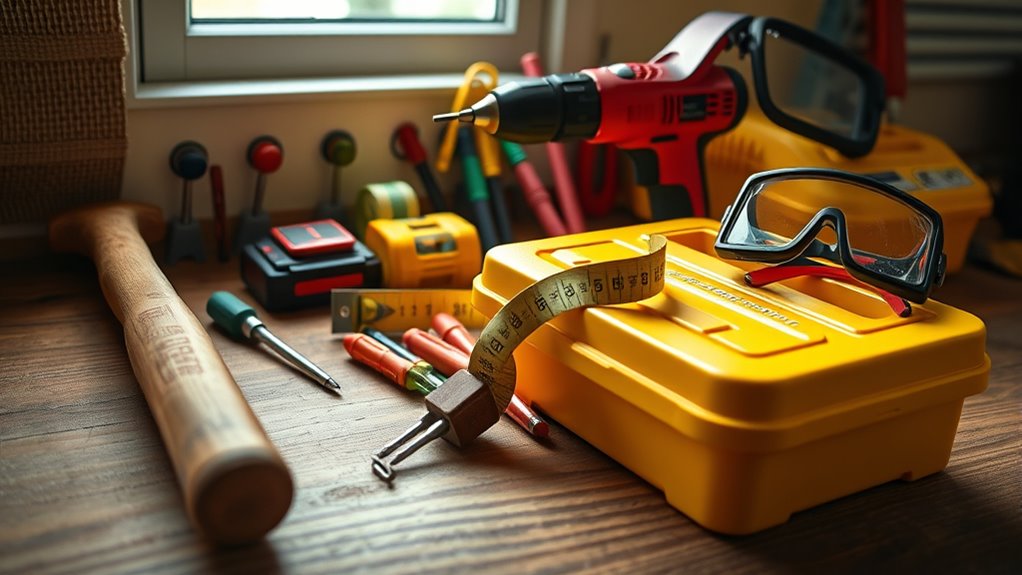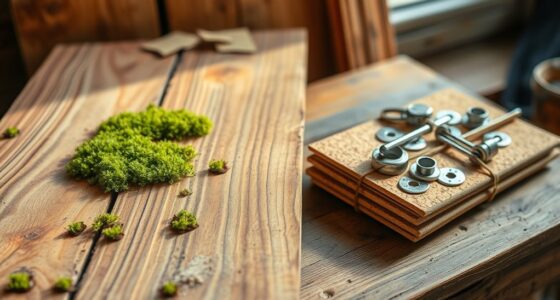As a home DIY beginner, having the right essential tools makes your projects safer and easier. Start with basic hand tools like screwdrivers, hammers, and tape measures. Invest in beginner-friendly power tools such as cordless drills and circular saws. Use measuring and leveling instruments like laser distance meters and spirit levels to guarantee precision. Don’t forget safety gear like goggles, gloves, and masks. With these tools, you’ll be well on your way—continue exploring to master each step.
Key Takeaways
- Start with basic hand tools like screwdrivers, hammers, and pliers for versatile DIY tasks.
- Invest in beginner-friendly cordless drills and circular saws for efficient cutting and drilling.
- Use measuring tools such as laser distance meters and spirit levels for accurate, professional results.
- Prioritize safety gear including goggles, gloves, and masks to ensure safe working conditions.
- Maintain tools properly through cleaning and storage to extend their lifespan and ensure safety.
Basic Hand Tools
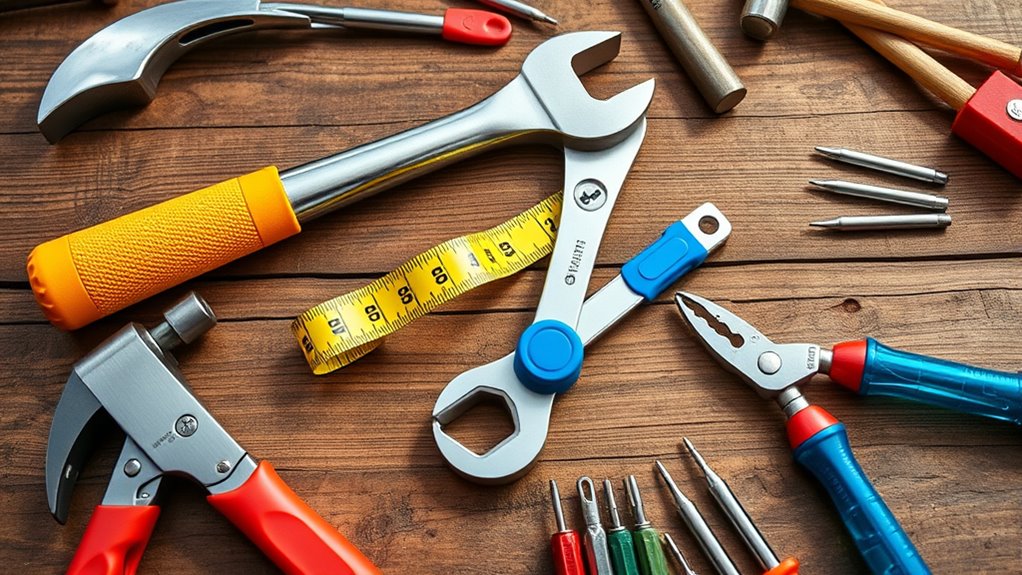
A set of basic hand tools is essential for any DIY beginner. These tools form the foundation of your projects and make tasks more manageable. To keep them effective, practice proper hand tool maintenance—clean, sharpen, and store them correctly to prolong their lifespan. When selecting tools, focus on ergonomic tool design; comfortable grips reduce fatigue and improve control during use. Hand tools like screwdrivers, hammers, pliers, and tape measures are versatile and easy to learn. Investing in quality handles and well-balanced tools ensures safety and efficiency. Remember, well-maintained and ergonomically designed tools make your DIY tasks smoother and more enjoyable, helping you build confidence as you develop your skills. Incorporating automation’s role in business intelligence can also streamline your project planning and decision-making processes.
Power Tools for Beginners
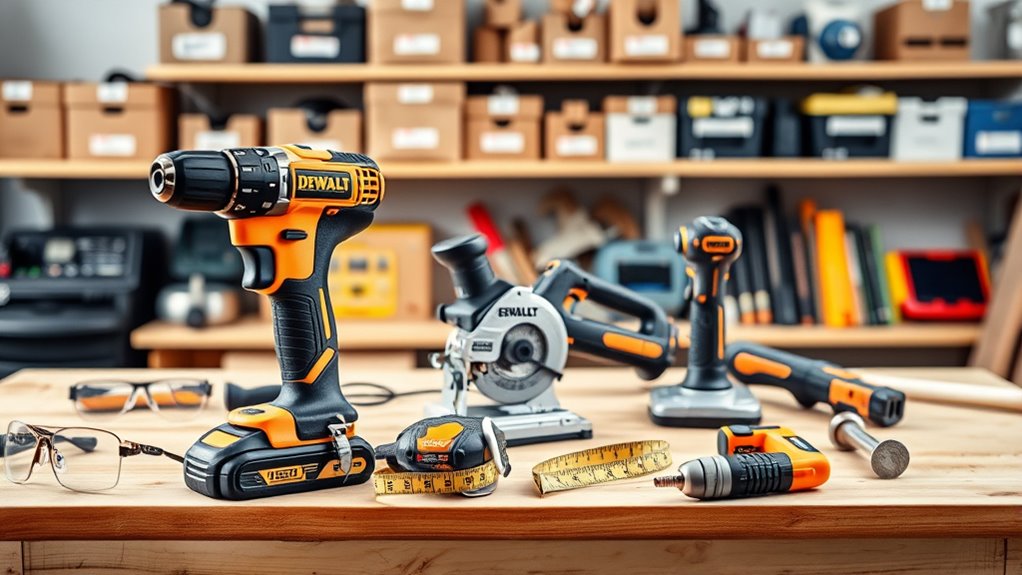
Ever wondered which power tools are best suited for beginners? Cordless drills are a must-have, offering versatility for drilling holes and driving screws with ease. Circular saws are also great for making straight cuts in wood, perfect for projects like shelving or furniture. These tools are user-friendly and provide control, making them ideal for those just starting out. When choosing power tools, look for lightweight models with ergonomic handles for comfort. Always wear safety gear and read the instructions carefully. Investing in quality beginner-friendly tools saves frustration and guarantees safety. With a cordless drill and a circular saw, you can handle a variety of basic home projects confidently. These essentials will help you build your skills and tackle DIY tasks efficiently. Additionally, understanding power tool safety is crucial to prevent accidents and ensure successful projects.
Measuring and Leveling Instruments
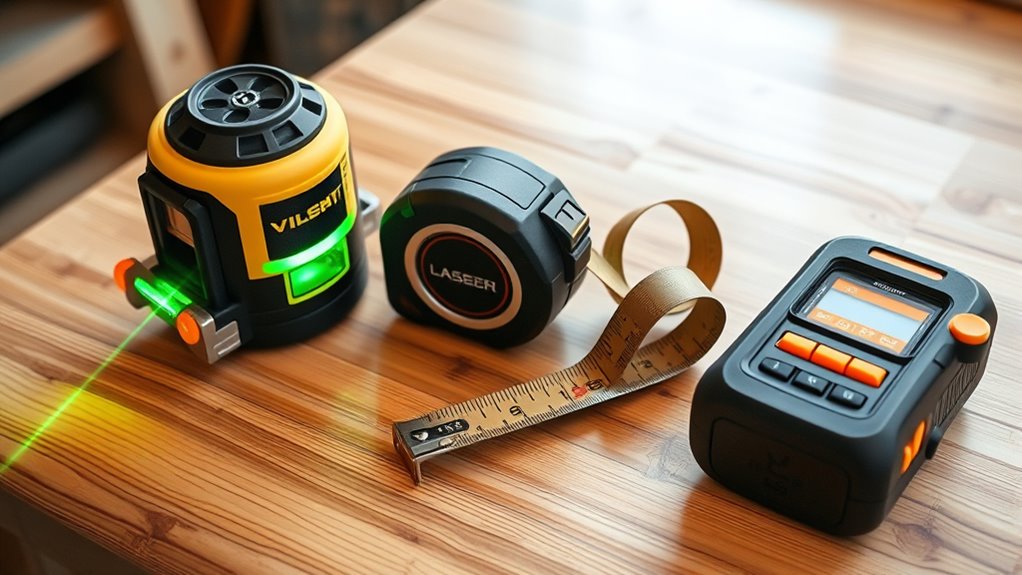
To guarantee your DIY projects come out straight and level, investing in reliable measuring and leveling instruments is vital. A laser distance meter helps you measure long distances quickly and accurately, saving time and reducing errors. It’s perfect for hanging shelves, installing cabinets, or framing walls. A spirit level ensures your surfaces are perfectly horizontal or vertical, preventing crooked installations. Using these tools together improves precision and confidence in your work. Laser distance meters make measurements easier in tight or hard-to-reach spots, while a spirit level provides immediate visual confirmation of alignment. Both are beginner-friendly but essential for professional-looking results. Additionally, understanding automation in business can inspire you to streamline your DIY process and incorporate innovative tools, making your projects more efficient and enjoyable. With these instruments, you’ll avoid costly mistakes and achieve more polished, stable, and visually appealing projects.
Safety Gear and Accessories
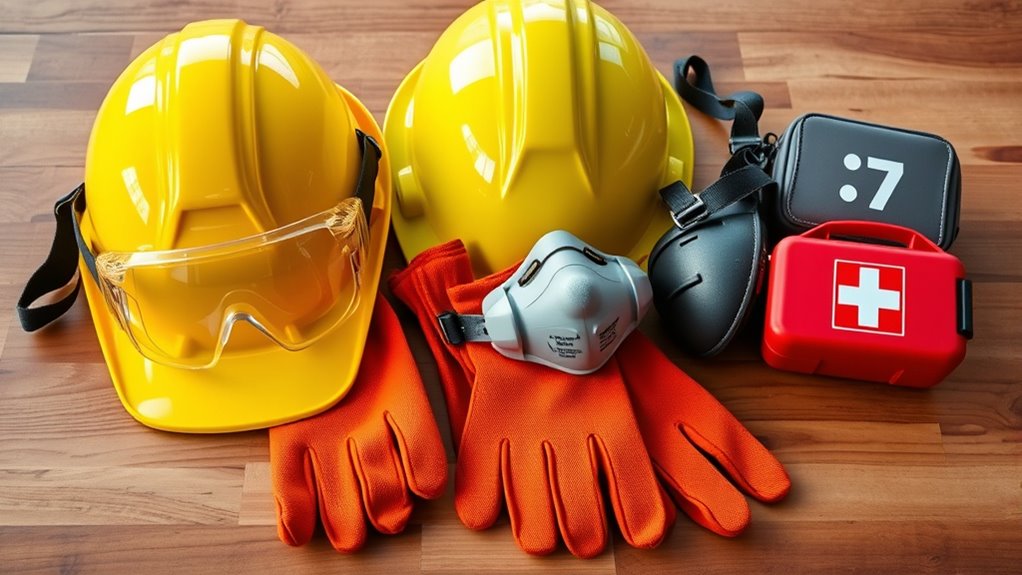
Using the right measuring and leveling tools helps you achieve precise results, but safety gear is what keeps you protected throughout your DIY projects. Wearing protective eyewear shields your eyes from debris, dust, and splashes. Ear protection minimizes noise from loud tools like drills and saws, preventing hearing damage. Safety gloves protect your hands from cuts, splinters, and chemicals. A dust mask keeps particles out of your lungs during sanding or grinding. Additionally, a sturdy helmet or hard hat safeguards your head from falling objects. Always prioritize safety by investing in quality gear. Proper air purifier maintenance ensures the equipment functions effectively, minimizing exposure to airborne pollutants. Here are some essentials:
Prioritize safety with quality protective gear like eyewear, gloves, masks, and hard hats for successful DIY projects.
- Protective eyewear
- Ear protection
- Work gloves
- Dust mask
- Hard hat
Frequently Asked Questions
How Do I Choose the Right Tool for a Specific Project?
When choosing the right tool for a project, start by clearly understanding what you need to accomplish. Consider tool safety first—select tools with proper safety features. Keep your budget considerations in mind; don’t overspend on fancy equipment if basic tools will do. Research and read reviews to ensure reliability. Always use tools correctly and wear safety gear to prevent accidents. This approach helps you pick the best tool confidently for any project.
What Maintenance Do My Tools Require Over Time?
You need to regularly maintain your tools to keep them in top shape. Check for proper tool calibration, especially for precision tools, and adjust as needed. Prevent rust by keeping tools dry and applying a light coat of oil after use. Clean sawdust and debris from power tools, and store them in a dry place. Proper maintenance guarantees your tools stay reliable and last longer for all your DIY projects.
How Can I Store My Tools Effectively?
Oh, the irony of your tools lying everywhere when you need them! To avoid chaos, focus on smart storage solutions. Use a toolbox or a wall-mounted rack for easy access, and categorize tools by type. Proper tool organization keeps your workspace tidy, saves time, and prolongs your tools’ life. Invest in storage solutions that suit your space, and you’ll always find what you need without the frustration.
Are There Eco-Friendly or Sustainable Tool Options?
You wonder if there are eco-friendly or sustainable tool options. Yes, you can choose tools made from biodegradable materials that break down naturally, reducing waste. Recycled tool options are also great—they’re crafted from repurposed metals or plastics, minimizing environmental impact. By selecting these sustainable tools, you support eco-conscious practices while building or fixing around your home. It’s a smart way to stay green and get your DIY projects done effectively.
How Do I Identify Quality Tools From Cheap Alternatives?
When identifying quality tools, focus on tool durability and brand reputation. You can usually tell by checking the material quality—sturdy metals and well-made handles signal durability. Reputable brands often offer better warranties and consistent performance, so look for trusted names. Avoid cheap alternatives with flimsy construction or poor reviews. Investing in reliable tools guarantees they last longer and perform better, saving you money and frustration in your DIY projects.
Conclusion
With these tools in your arsenal, you’re ready to turn your home improvement dreams into reality. Think of your toolbox as a painter’s palette, ready to craft your masterpiece. Each screw tightened and board leveled adds to your growing confidence. So, plunge in with enthusiasm and watch your skills blossom like a garden in full bloom. Your DIY journey is just beginning—embrace it and create something truly spectacular!
